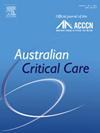Live music in the intensive care unit—A mixed-methods pilot study exploring the experience and impact of live music played for the adult intensive care patient
IF 2.6
3区 医学
Q2 CRITICAL CARE MEDICINE
引用次数: 0
Abstract
Background
Evidence for music's beneficial effect on physical and mental disorders is mounting. Intensive care unit (ICU) patients experience multiple uncomfortable symptoms, which may be alleviated using a music-based intervention. Few studies have examined the experience and the physical impact of patient-tailored live music offered by trained health musicians in an adult ICU.
Aims
This study aimed to explore the experience of live music in adult patients admitted to an ICU, focusing on its effects on relaxation, stress, and pain.
Study design
A pilot study with a convergent mixed-methods design. A total of 27 intensive care patients at a Danish University Hospital were offered patient-tailored live music by trained musicians in a single-session design. We performed participant observation and conducted patient interviews using an observational and semistructured interview guide. These data were supported by quantitative pre-post measurements of heart rate, respiration rate, mean arterial blood pressure, subjective pain experience, and heart-rate variability. The study was conducted from February 2020 to December 2021.
Findings
Using a Ricoeur-inspired analysis of observations and interviews, we elicited four themes: ‘A break where you can swim away and relax’, ‘The living presence makes the play unique’, ‘Happy memories of the past and longing for home’, and ‘An intense and meaningful experience’. The quantitative analysis showed a significant decrease in heart rate (4.33 bpm, p < 0.02), respiration rate (2.93, p < 0.001), and blood pressure (3.30, p < 0.05) and a significant increase in heart-rate variation (−0.22, p < 0.01). Seven patients reported pain reduction after the music intervention, corresponding to a 24% reduction.
Conclusion
Live music contributes to meaningful moments by bringing elements of everyday life into the ICU and may promote relaxation and reduce stress and pain.
Relevance to clinical practice
Our findings indicate that live music is a nonpharmacological experience that creates meaningful moments for critically ill patients.
重症监护室中的现场音乐--探索为成年重症监护患者播放现场音乐的体验和影响的混合方法试点研究。
背景:越来越多的证据表明,音乐对身体和精神疾病有益。重症监护病房(ICU)患者会出现多种不适症状,而音乐干预可以缓解这些症状。很少有研究对成人重症监护病房中由训练有素的健康音乐家为患者量身定制的现场音乐所带来的体验和对身体的影响进行研究:研究设计:试验性研究,采用聚合混合方法设计。丹麦一所大学医院共为 27 名重症监护患者提供了由训练有素的音乐家为患者量身定制的现场音乐,采用的是单次疗程设计。我们采用观察法和半结构化访谈指南对患者进行了观察和访谈。这些数据得到了心率、呼吸频率、平均动脉血压、主观疼痛体验和心率变异性的定量前后测量结果的支持。研究时间为 2020 年 2 月至 2021 年 12 月:通过对观察和访谈进行里科尔启发式分析,我们得出了四个主题:"可以游泳放松的休息时间"、"生命的存在使游戏独一无二"、"对过去的快乐回忆和对家的渴望 "以及 "紧张而有意义的体验"。定量分析显示,心率明显降低(4.33 bpm,p 结论:"现场音乐有助于创造有意义的时刻":现场音乐将日常生活元素带入重症监护室,有助于创造有意义的时刻,并可促进放松、减轻压力和疼痛:我们的研究结果表明,现场音乐是一种非药物体验,能为重症患者创造有意义的时刻。
本文章由计算机程序翻译,如有差异,请以英文原文为准。
求助全文
约1分钟内获得全文
求助全文
来源期刊

Australian Critical Care
NURSING-NURSING
CiteScore
4.90
自引率
9.10%
发文量
148
审稿时长
>12 weeks
期刊介绍:
Australian Critical Care is the official journal of the Australian College of Critical Care Nurses (ACCCN). It is a bi-monthly peer-reviewed journal, providing clinically relevant research, reviews and articles of interest to the critical care community. Australian Critical Care publishes peer-reviewed scholarly papers that report research findings, research-based reviews, discussion papers and commentaries which are of interest to an international readership of critical care practitioners, educators, administrators and researchers. Interprofessional articles are welcomed.
 求助内容:
求助内容: 应助结果提醒方式:
应助结果提醒方式:


